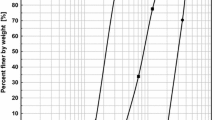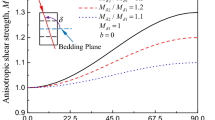Abstract
In this paper, a comprehensive laboratory study was done on the shear behavior of the interface between geomembrane and an adjacent sandy layer using a modified direct shear test apparatus. The key parameters for this investigation included roughness of geomembrane surface, sedimentation angles of a specifically selected sand, and applied normal stress, for which a total of 162 tests were conducted, excluding reliability tests. As an indicator of all the mentioned samples, a formulation was obtained using response surface methodology (RSM) model. The results of the study were in line with previously published findings in this subject matter. The test results indicated that friction angle is highly influenced by the sand anisotropy where the maximum frictional resistance occurred at an orthogonal angle and decreased with the increase in the degree of induced anisotropy. The variations were more noticeable for the sand than sand–geomembrane interface with a minimum for the roughest interface that confirmed the reduction in anisotropy effects on shear strength with the increase in surface roughness.











Similar content being viewed by others
Abbreviations
- R a :
-
Arithmetic average height
- y i :
-
Vertical distance from the mean line to the ith data point
- ϕ p :
-
Peak friction angle
- ψ b :
-
Bedding plane inclination
- τ p :
-
Peak shear strength
- σ n :
-
Normal stress
References
Park HI, Lee SR (2005) Effects of equipment loadings on geosynthetic-lined slope behaviour. Waste Manag Res 23(3):240–248
Koerner RM, Soong TY (2000) Stability assessment of ten large landfill failures. In: Proceedings of advances transport geoenvironment systems using geosynthesis, Geo-Denver, pp 1–38
Koerner RM (1990) Designing with geosynthetics. Prentice Hall publishing Co, USA
Veiskarami M, Jamshidi Chenari R, Jameei AA (2017) Bearing capacity of strip footings on anisotropic soils by the finite elements and linear programming. Int J Geomech 17(12):04017119
Hsieh C, Hsieh M (2003) Load plate rigidity and scale effects on the frictional behavior of sand/geomembrane interfaces. Geotext Geomembr 21:25–47
Palmeira EM (2009) Soil-geosynthetic interaction: modelling and analysis. Geotext Geomembr 27(5):368–390
Gao J, Zhang M, Zhang W (2009) Interface frictional property between sand and geomembrane. In: Proceedings of first international symposium on geoenvironment engineering, pp 822–827.
Vangla P, Latha GM (2015) Influence of particle size on the friction and interfacial shear strength of sands of similar morphology. Int J of Geosynth Ground Eng 1(1):1–6
Vangla P, Gali ML (2016) Shear behavior of sand-smooth geomembrane interfaces through micro-topographical analysis. Geotext Geomembr 44(4):592–603
Viswanadham BVS (2019) Centrifuge model studies on the performance of geosynthetic-reinforced soil structures. Frontiers in geotechnical engineering. Springer, Singapore, pp 157–158
Liu H, Martinez J (2014) Creep behaviour of sand-geomembrane interfaces. Geosynth Int 21(1):83–88
Cen WJ, Bauer E, Wen LS, Wang H, Sun YJ (2019) Experimental investigations and constitutive modeling of cyclic interface shearing between HDPE geomembrane and sandy gravel. Geotext Geomembr 47(2):269–279
Zabielska-adamska K (2019) Water content-density criteria for determining geomembrane-fly ash interface shear strength. MATEC Web Conf. https://doi.org/10.1051/matecconf/201926204005
Pakdel P, Jamshidi Chenari R, Veiskarami M (2019) An estimate of the bearing capacity of shallow foundations on anisotropic soil by limit equilibrium and soft computing technique. Geomech Geoeng 14(3):202–217
Bagchi A (1994) Design, construction and monitoring of landfills. Wiley, USA
Casagrande A (1944) Shear failure of anisotropic materials. Proc Boston Soc Civ Eng 31:74–87
Jovičić V, Coop MP (1998) The measurement of stiffness anisotropy in clays with bender element tests in the triaxial apparatus. Geotech Test J 21(1):3–10
Shahnazari H, Maghoul M, Alizadeh M, Javadi AS (2018) Effect of anisotropy on shear behavior of Hormoz carbonate sand. Int J Geotech Eng 12(5):484–490
Wong RKS, Arthur JRF (1985) Induced and inherent anisotropy in sand. Geotechnique 35(4):471–481
Arthur JRF, Menzies B (1972) Inherent anisotropy in a sand. Geotechnique 22(1):115–128
Tatsuoka F, Nakamura S, Huang C, Tani K (1990) Strength anisotropy and shear band direction in plane strain tests of sand. Soils Found 30(1):35–54
Phillips AB, May PH (1967) A form of anisotropy in granular media. Special Task Report, Univ College London, UK
Oda M, Konishi J (1974) Microscopic deformation mechanism of granular material in simple shear. Soils Found 14(4):25–38
Oda M, Konishi J (1974) Rotation of principal stresses in granular material during simple shear. Soils Found 14(4):39–53
Oda M, Koishikawa I, Higuchi T (1978) Experimental study of anisotropic shear strength of sand by plane strain test. Soils Found 18(1):25–38
Alshibli KA, Sture S (2000) Shear band formation in plane strain experiments of sand. J Geotech Geoenv Eng 126(6):495–503
Hight DW, Gens A, Symes MJ (1983) The development of a new hollow cylinder apparatus for investigating the effects of principal stress rotation in soils. Geotechnique 33(4):355–383
Gutierrez M, Ishihara K, Towhata I (1991) Flow theory for sand during rotation of principal stress direction. Soils Found 31(4):121–132
Lade PV, Nam J, Hong WP (2008) Shear banding and cross-anisotropic behavior observed in laboratory sand tests with stress rotation. Can Geotech J 45(1):74–84
Cai Y, Yu H-S, Wanatowski D, Li X (2012) Noncoaxial behavior of sand under various stress paths. J Geotech Geoenv Eng 139(8):1381–1395
Dołżyk-Szypcio K (2019) Direct shear test for coarse granular soil. Int J Civ Eng 17(12):1871–1878
Zarei C, Soltani-Jigheh H, Badv K (2019) Effect of inherent anisotropy on the behavior of fine-grained cohesive soils. Int J Civ Eng 17(6):687–697
Symes MJ, Gens A, Hight DW (1988) Drained principal stress rotation in saturated sand. Geotechnique 38(1):59–81
Vaid YP, Sayao A, Enhuang H, Negussey D (1990) Generalized stress-path-dependent soil behaviour with a new hollow cylinder torsional apparatus. Can Geotech J 27(5):601–616
Rolo R (2004) The anisotropic stress-strain-strength behaviour of brittle sediments. PhD Thesis, Imperial College London, UK
Yu H-S, Yang L-T, Li X, Wanatowski D (2016) Experimental investigation on the deformation characteristics of granular materials under drained rotational shear. Geomech Geoeng 11(1):47–63
Fu P, Dafalias YF (2011) Study of anisotropic shear strength of granular materials using DEM simulation. Int J Numer Anal Methods Geomech 35(10):1098–1126
Tong Z, Fu P, Zhou S, Dafalias Y (2014) Experimental investigation of shear strength of sands with inherent fabric anisotropy. Acta Geotech 9(2):257–275
Farhadi B, Lashkari A (2017) Influence of soil anisotropy on behavior of crushed sand-steel interface. Soils Found 57:111–125
Afzali-Nejad A, Lashkari A, Farhadi B (2018) Role of soil inherent anisotropy in peak friction and maximum dilation angles of four sand-geosynthetic interfaces. Geotext Geomembr 46(6):869–881
Lashkari A, Jamali V (2020) Global and local sand-geosynthetic interface behavior. Géotechnique. https://doi.org/10.1680/jgeot.19.P.109
Gao JL, Zhang MX, Zhang WJ (2009) Interface frictional property between sand and geomembrane. In: Proceedings of international symposium on geoenvironment engineering, Hangzhou, China
Krumbein WC (1941) Measurement and geological significance of shape and roundness of sedimentary particles. J Sediment Res 11(2):64–72
Al-Hashemi HMB, Al-Amoudi OSB (2018) A review on the angle of response of granular materials. Powder Tech 330:397–417
Basudhar PK (2010) Modeling of soil-woven geotextile interface behavior from direct shear test results. Geotext Geomembr 28(4):403–408
Gadelmawla ES, Koura M, Maksoud TMA, Elewa IM (2002) Roughness parameters. J Mater Process Tech 123(1):133–145
Matsuoka H, Liu S (1998) Simplified direct box shear test on granular materials and its application to rockfill materials. Soils Found 38(4):275–284
Dove JE (1996) A method for measuring geomembrane surface roughness. Geosynth Int 3(3):369–392
Barber JR, Ciavarella M (2000) Contact mechanics. Int J Solids Struct 37(1–2):29–43
Komvopoulos K, Ye N (2001) Three-dimensional contact analysis of elastic-plastic layered media with fractal surface topographies. J Tribol 123(3):632–640
Mo Y, Turner KT, Szlufarska I (2009) Friction laws at the nanoscale. Nature 457(7233):1116–1119
Brake MR (2012) An analytical elastic-perfectly plastic contact model. Int J Solids Struct 49(22):3129–3141
Author information
Authors and Affiliations
Corresponding author
Rights and permissions
About this article
Cite this article
Asl Faregh, A.H., Hamidi, A. Impact of Inherent Anisotropy on the Shear Behavior of Sand–Textured Geomembrane Interface. Int J Civ Eng 18, 1113–1123 (2020). https://doi.org/10.1007/s40999-020-00519-2
Received:
Revised:
Accepted:
Published:
Issue Date:
DOI: https://doi.org/10.1007/s40999-020-00519-2




